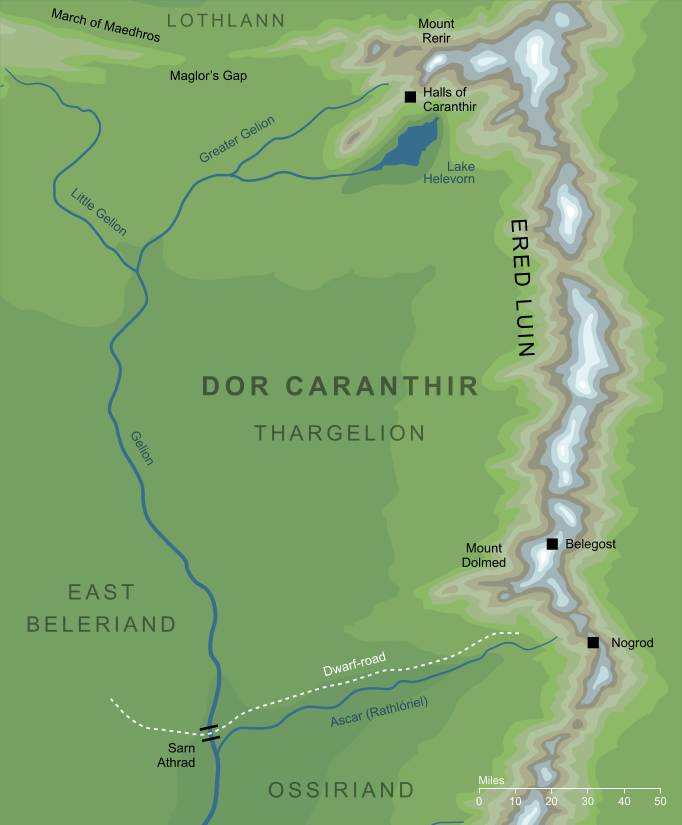
Slightly conjectural2
Slightly conjectural2
A later name given to the wide lands eastward of the river Gelion and northward of the river Ascar during the First Age. This region at the feet of the Blue Mountains had originally been known to the Sindar simply as Talath Rhúnen, the East Vale, but when the Noldor returned to Middle-earth, they gave it new names, including Thargelion, the 'land beyond Gelion'. When Fëanor's fourth son Caranthir chose this land as his dwelling-place, it acquired another new name: Dor Caranthir, the Land of Caranthir.
Caranthir's people settled primarily in the northern parts of the land. In that part of Thargelion, a spur of the Blue Mountains extended westward, forming the height of Mount Rerir before the land descended into Maglor's Gap. Caranthir had his fortified halls on the western flanks of Mount Rerir, overlooking Lake Helevorn. That cold lake formed in the angle between the Blue Mountains and their western spur, and Caranthir's people settled around its shores and in the surrounding lands.
These new settlers climbed the Blue Mountains to the east, and there they encountered the Dwarves. In former times, the Dwarves had trafficked with Thingol and the Sindar, but the re-emergence of Morgoth had driven them away from Beleriand. The Noldor of Caranthir and the Dwarves of the Blue Mountains were mutually suspicious, but recognised their common interests, and both grew wealthy from the trading alliance that developed between them.
The southern parts of Dor Caranthir remained unpopulated for some centuries, until the coming of Men into Beleriand. One house of these newcomers, the people known as the Haladin, came out of the Blue Mountains and passed down the river Ascar that formed Dor Caranthir's southern border. They camped northward of the river, in its angle with Gelion (that is, in the southwestern parts of the land). These people were later attacked by marauding Orcs who had crept down the eastern side of the mountains and followed the westward way through the passes. These Orcs devastated the Haladin, forcing them back into a desperate defence against the rivers. At last, after seven days of siege, Caranthir rode southward with his people and relieved the besieged Men. Impressed with their bravery, the Elf-lord offered to take them into his service and under his protection, but their leader Haleth demurred. Instead she led her people far away from the shadows of the eastern mountains, eventually to settle in the distant Forest of Brethil.
The fall of Dor Caranthir came in the Dagor Bragollach, when Orcs swarmed across the borderlands defended by the Sons of Fëanor. Joined by the Dragon Glaurung, the Orcs assailed and captured Caranthir's fortress on Mount Rerir, and the clear waters of Lake Helevorn were defiled by the invaders.
Caranthir himself survived the loss of his land, fleeing into the south with the survivors of his people. For a time, he joined his brothers Amrod and Amras on the broad hill of Amon Ereb. Together they fortified the hill and held it for some fifty years, until the time when they joined the other Sons of Fëanor in a raid on the kingdom of Doriath. The brothers sought to reclaim the Silmaril that was held there, but in that they failed, and Caranthir was slain in the fighting.
After the invasion of the Orcs and the flight of Caranthir, Dor Caranthir makes no further appearance in history. Less than a hundred years after Caranthir had fled from his land, the Valar sent their forces against Morgoth, and much of Beleriand was drowned in the ensuing War of Wrath. The lands east of Gelion were not spared this cataclysm entirely, but much of the old land of Dor Caranthir survived, now lying on the new western coasts of Middle-earth. As the Second Age began, it was occupied by Elves once again, and became Forlindon, the northern part of the land of Lindon.
Notes
1 |
For a time, there was also a colony of Men living in the southern parts of Dor Caranthir. These Haladin were led away into the west by Haleth, to settle eventually in the Forest of Brethil. |
2 |
The geography of Dor Caranthir is generally well mapped, with the exception of the halls of Caranthir, whose location is only approximately known from textual references, and what references we have are hard to reconcile. According to Quenta Silmarillion 14, Of Beleriand and its Realms, '...beside [Helevorn] Caranthir had his abode...'. However, in QS 18, Of the Ruin of Beleriand and the Fall of Fingolfin, we're told of the fall of these halls '...the Orcs took the fortress upon the west slopes of Mount Rerir...'. Given the geography of this region, it is difficult to see how Caranthir's fortress could have been both beside the lake and on the western slopes of the mountain. The map above presents a compromise, placing the halls on the southwestern slope of the mountain, thus also allowing them to fall close to the shores of the lake.
|
Indexes:
About this entry:
- Updated 8 January 2023
- This entry is complete
For acknowledgements and references, see the Disclaimer & Bibliography page.
Original content © copyright Mark Fisher 2002, 2004, 2017, 2023. All rights reserved. For conditions of reuse, see the Site FAQ.

